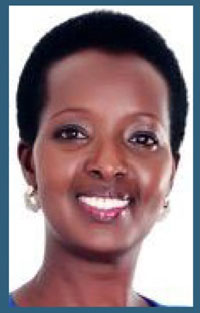
Driving on the road to an AIDS-free Uganda; Commemorating World AIDS day 2022
COMMENT | Allen Kagina | In the mid-1980s to early 1990s, the new NRA government of Uganda was grappling with the uphill task of reorganising a country ravaged by instability, economic adversity, and human capital inadequacies, among which a sick and unproductive population was a significant concern. HIV/AIDS prevalence peaked at 18%, a disease the populace barely knew how to manage, let alone acknowledge its existence. Families were decimated, and children were orphaned at the hands of this disease.
In her memoir, “My Life’s Journey”, First Lady Janet Museveni details the efforts in establishing the Uganda Women’s Efforts to Save Orphans (UWESO), an NGO which has been in operation since 1986 to help the scores of children whom the HIV/AIDS epidemic had orphaned. The revered African culture of taking up an orphan, usually by relatives, had collapsed at the hands of the epidemic calling for such admirable efforts as UWESO and various other organisations. Such was the depth of the problem.
The task of leading the Ugandan population out of this situation fell on the then-new NRA government, a success story that has been lauded worldwide. Currently, of the 1.4 million people living with HIV, more than 1,000,000 people are enrolled in care. HIV/AIDS is still a concern, but with hindsight, we can now truly appreciate the journey and probe it for current planning and execution. As we speak, Uganda is on the arduous but positive fast track to ending HIV/ AIDS for good.
On June 16th 2017, President Yoweri Museveni launched the Presidential Fast-Track Initiative (PFTI), which aims to end AIDS by 2030 as one of Uganda’s public health threats. The president holds the right view that HIV/ AIDS is not just a health problem. It comes with profound economic, political, and social consequences. It is common wisdom that HIV/AIDS is both a cause and an outcome of poverty, and poverty is both a cause and an effect of HIV/AIDS. It, therefore, demands a multi-faceted, multi-sectoral response with an HIV component embedded in all sectoral plans.
The infrastructural and transport sector is one of the critical sectors in combating HIV. The government of Uganda has, over the years, prioritised Infrastructure Development as one of the core areas to drive Social-Economic transformation. In the roads sector alone, through the Uganda National Roads Authority- UNRA under the Ministry of Works and Transport, over 6000 kilometres of the National Road Network have been paved, with 11 ferries plying the waterways.
The growth in road infrastructure we have had in the country speaks to something more profound. It’s not just about a new shiny paved road. It is about a pregnant mother getting easy access to prenatal HIV testing and counselling. It is caseworkers reaching their destinations with ease and speed. It is the growth that follows a road project which boosts the skills and incomes of the communities hence improving their access to HIV prevention tools and facilities. It is the ability to use public transport to disseminate information. It is a girl escaping early marriage because a bridge was built to connect her to a school.
Indeed, road development may have a bi-directional effect on HIV. On the one hand, the social-economic transformation that comes with this developed infrastructure has positive outcomes for the HIV fight. HIV rates are inversely related to household incomes, directly correlating with improved infrastructure and other positive correlations, including improved healthcare access and information dissemination.
On the other hand, road development may pose some risks to the HIV fight. During construction, the congregation of project workers, usually away from their families, may increase their predisposition to engage in risky behaviors. This has been fully demonstrated in what has come to be termed the “payday syndrome”, where there’s an influx of sex workers at construction sites on the day payments are made. Further, the improved mobility which comes with constructed roads may facilitate HIV transmission.
📻Live on Kinkizi 88.2FM:
Our project team is now engaging locals along Rukungiri—Ishasha/Kihiihi—Kanungu road project on social issues including Child Labour & Protection, HIV/AIDS awareness, & sharing progress on Civil works & Compensation. #StaySafeUg 😷 #UNRAworks pic.twitter.com/MIR6hLnmvG— UNRA_UGANDA (@UNRA_UG) July 10, 2020
#SocialSafeguards— Working with @AICuganda in conducting HIV Testing & Counselling outreaches for Construction workers & the Community.
Individuals are able to know their HIV status & can ably make informed decisions to protect themselves. #WBGMeetings #UNRAworks #globalhealth pic.twitter.com/mQIBSh6N2w
— UNRA_UGANDA (@UNRA_UG) April 16, 2019
Conscious of these risks, UNRA implements an HIV / AIDS, Gender Based Violence Occupational Safety and Gender Programme as part of Civil works contracts for all road projects. This includes activities to increase awareness of the dangers of HIV / AIDS to promote appropriate preventative measures and help reduce the impact on those already infected or affected by HIV. It also involves sensitisation on gender issues and addresses projects’ occupational safety and health aspects. This program focuses on four major themes, which include; HIV/AIDs awareness and control among the workforce and communities, gender mainstreaming and prevention of gender-based violence, child care and protection, and occupational health and safety.
The program includes undertaking HIV/AIDS sensitisation among workers and communities, encouraging and conducting voluntary HIV testing, Condom education and distribution to target communities, and distributing information and Educative and Communication (IEC) materials on HIV/AIDS/ Gender Based Violence (GBV).
A sneak peek into some of UNRA’s projects can paint a picture of the efforts. In the last quarter, on the HIV/AIDS/ GBV front, several activities were conducted on all the ongoing projects. To mention a few, we had six sensitisation engagements on the ongoing Kiira-Matugga project, reaching out to 169 workers and members of the communities, 15 sensitisation engagements reaching out to 666 workers and community members on the Busega-Mpigi expressway project, ten sensitisation engagements reaching out to 4199 workers and members of the community on the Muyembe-Nakapiripit project and 21 sensitisation engagements reaching out to 1,214 workers and community members on the ongoing Kapchorwa-Suam project. These resulted in increased awareness of HIV prevention, with 988 people tested for HIV in the last quarter alone.
As we mark World AIDS day 2022, let’s take a moment to reflect on how far we have come regarding the HIV fight in Uganda. In line with this year’s theme, let us put ourselves to the test and achieve equity to end HIV. Let’s all play our part, on a national scale, in supporting the Presidential Fast-Track Initiative (PFTI) to end AIDS by 2030 while taking responsibility for our lives on an individual level. The goal to end AIDS by 2030 is a genuinely achievable one. At UNRA, we acknowledge that there is still a lot to be done, but the lessons we’ve learned along the way tell us we are on the right path.
*******
 Allen Kagina is the Executive Director, Uganda National Roads Authority.
Allen Kagina is the Executive Director, Uganda National Roads Authority.
 The Independent Uganda: You get the Truth we Pay the Price
The Independent Uganda: You get the Truth we Pay the Price



